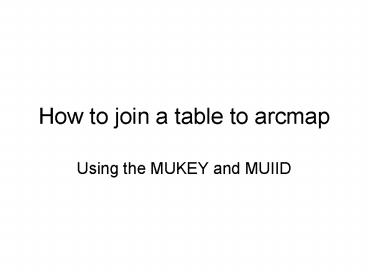How to join a table to arcmap - PowerPoint PPT Presentation
1 / 23
Title:
How to join a table to arcmap
Description:
The SSURGO data is pretty dense so your map will appar black until you join and add a legend. ... been possible to define the symbols and ranges and labels from ... – PowerPoint PPT presentation
Number of Views:45
Avg rating:3.0/5.0
Title: How to join a table to arcmap
1
How to join a table to arcmap
- Using the MUKEY and MUIID
2
Run the report in NASIS to create a .txt file
with MUIID as one of the field. Then start EXCEL
and open the .txt file.
3
Choose Delimited.
4
Check Other and the symbol if that is the
file type that you have run. Other delimiters
that work are comma delimited or tab delimited.
5
Make sure that you choose Text as the type for
the MUIID column. If not, the join will not work
because the MUKEY in the spatial data is text.
6
Choose DBF 4 (dBASE IV) as the file type of
choice to save.
7
Just confirm with a YES.
8
Add the spatial data to your arcMap session using
the add data tool.
9
In this case I am adding a shape file that
contains the data from Kansas and Nebraska that
comprises MLRA 106.
10
The SSURGO data is pretty dense so your map will
appar black until you join and add a legend.
11
Then choose the add data button again and add the
.dbf file.
12
Right click on the the layer and open the
attribute table just to see what is in it.
13
Notice that the MUIID field is left justified and
the COIID field is right justified. That means
that the MUIID field is recorded as TEXT and the
COIID field is still numbers. It is important
that the MUIID be TEXT or it will not join
properly.
14
Now right click on the soils layer and choose gt
joins and relates gt join.
15
Choose Join Attributes from a table gt MUKEY gt
DWOB and MUIID
16
Once you have joined the DBF file to the Spatial
Attribute table, right click again and go to
properties.
17
Choose the symbology tab.
18
In this case I imported the symbology from
another map. You can just create your own if you
wish.
19
In this case the allinterps layer file had all
the information that I needed so I used it
instead of creating my own symbology.(look of the
map)
20
This is the field that I want to match the
symbology to.
21
This is the symbology that will be imported. It
would have been possible to define the symbols
and ranges and labels from scratch, but importing
the symbology meant that I would not have to make
all of these definitions.
22
This is the resulting map
23
On the screen it is not necessarily possible to
see all of the detail that will be printed. This
is a closeup of a section of the map and
represents what will actually get printed on a
reasonable sized map.

